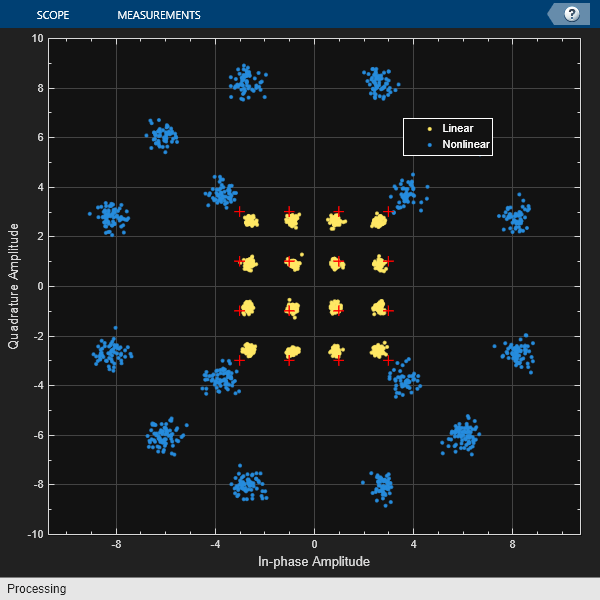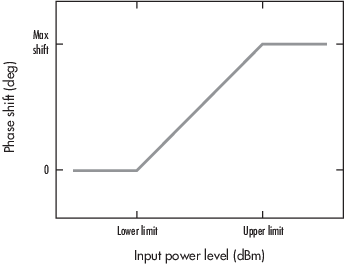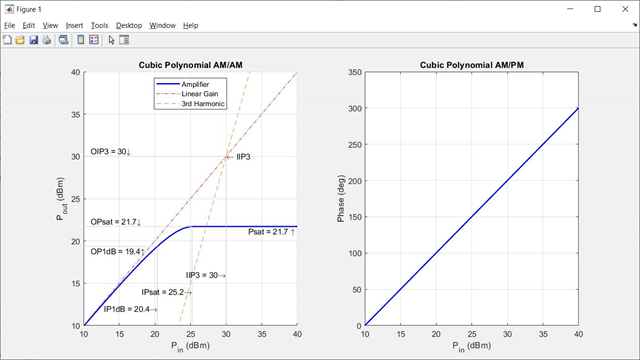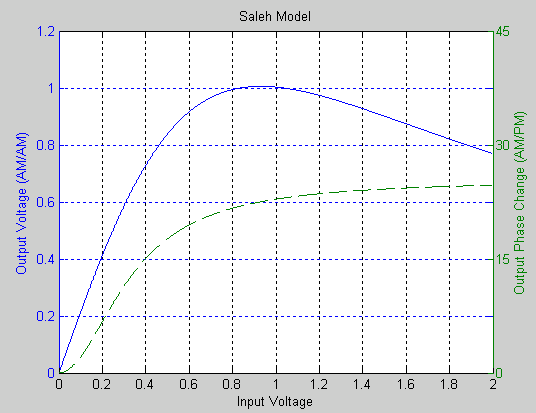comm.MemorylessNonlinearity
Apply memoryless nonlinearity to complex baseband signal
Description
The comm.MemorylessNonlinearity
System object™ applies memoryless nonlinear impairments to a baseband signal. Use this
System object to model memoryless nonlinear impairments caused by signal amplification in a
radio frequency (RF) transmitter or receiver. For more information, see Memoryless Nonlinear Impairments.
To apply memoryless nonlinear impairments to a complex baseband signal:
Create the
comm.MemorylessNonlinearityobject and set its properties.Call the object with arguments, as if it were a function.
To learn more about how System objects work, see What Are System Objects?
Creation
Description
mnl = comm.MemorylessNonlinearity
mnl = comm.MemorylessNonlinearity(Name=Value)'Method','Saleh model' sets the modeling
method to the Saleh method.
Properties
Unless otherwise indicated, properties are nontunable, which means you cannot change their
values after calling the object. Objects lock when you call them, and the
release function unlocks them.
If a property is tunable, you can change its value at any time.
For more information on changing property values, see System Design in MATLAB Using System Objects.
Nonlinearity modeling method, specified as 'Cubic polynomial',
'Hyperbolic tangent', 'Saleh model',
'Ghorbani model', 'Modified Rapp model', or
'Lookup table'. For more information, see Memoryless Nonlinear Impairments.
Data Types: char | string
Input signal scaling factor in decibels, specified as a scalar. This property scales the power gain of the input signal.
Tunable: Yes
Dependencies
To enable this property, set the Method
property to 'Saleh model' or 'Ghorbani
model'.
Data Types: double
Linear gain in decibels, specified as a scalar. This property scales the power gain of the output signal.
Tunable: Yes
Dependencies
To enable this property, set the Method
property to 'Cubic polynomial', 'Hyperbolic
tangent', or 'Modified Rapp model'.
Data Types: double
Third-order nonlinearity specification for cubic polynomial, specified as
'IIP3', 'OIP3', 'IP1dB',
'OP1dB', 'IPsat', or 'OPsat'.
For more information, see Cubic Polynomial Third-Order Coefficient.
Dependencies
To enable this property, set the Method
property to 'Cubic polynomial'.
Data Types: char | string
Third-order input intercept point in dBm, specified as a scalar.
Tunable: Yes
Dependencies
To enable this property, set the Method
property to 'Cubic polynomial' or 'Hyperbolic
tangent'.
Data Types: double
Third-order output intercept point in dBm, specified as a scalar.
Tunable: Yes
Dependencies
To enable this property, set the Method
property to 'Cubic polynomial' and the TOISpecification property to 'OIP3'.
Data Types: double
One dB input compression point in dBm, specified as a scalar.
Tunable: Yes
Dependencies
To enable this property, set the Method
property to 'Cubic polynomial' and the TOISpecification property to 'IP1dB'.
Data Types: double
One dB output compression point in dBm, specified as a scalar.
Tunable: Yes
Dependencies
To enable this property, set the Method
property to 'Cubic polynomial' and the TOISpecification property to 'OP1dB'.
Data Types: double
Input saturation point in dBm, specified as a scalar.
Tunable: Yes
Dependencies
To enable this property, set the Method
property to 'Cubic polynomial' and the TOISpecification property to 'IPsat'.
Data Types: double
Output saturation point in dBm, specified as a scalar.
Tunable: Yes
Dependencies
To enable this property, set the Method
property to 'Cubic polynomial' and the TOISpecification property to 'OPsat'.
Data Types: double
Linear AM/PM conversion factor in degrees per decibel, specified as a scalar. For more information, see Cubic Polynomial and Hyperbolic Tangent Model Methods.
Tunable: Yes
Dependencies
To enable this property, set the Method
property to 'Cubic polynomial' or 'Hyperbolic
tangent'.
Data Types: double
AM/AM parameters used to compute the amplitude gain for an input signal, specified as a row vector.
When the
Methodproperty is set to'Saleh model', this property must be a two-element vector that specifies alpha and beta values. In this case, the default value is[2.1587 1.1517].When the
Methodproperty is set to'Ghorbani model', this property must be a four-element vector that specifies x1, x2, x3, and x4 values. In this case, the default value is[8.1081 1.5413 6.5202 -0.0718].
For more information, see Saleh Model Method and Ghorbani Model Method.
Tunable: Yes
Dependencies
To enable this property, set the Method
property is set to 'Saleh model' or 'Ghorbani
model'.
Data Types: double
AM/PM parameters used to compute the phase change for an input signal, specified as a row vector.
When the
Methodproperty is set to'Saleh model', this property must be a two-element vector that specifies alpha and beta values. In this case, the default value is[4.0033 9.1040].When the
Methodproperty is set to'Ghorbani model', this property must be a four-element vector that specifies y1, y2, y3, and y4 values. In this case, the default value is[4.6645 2.0965 10.88 -0.003]
For more information, see Saleh Model Method and Ghorbani Model Method.
Tunable: Yes
Dependencies
To enable this property, set the Method
property is set to 'Saleh model' or 'Ghorbani
model'.
Data Types: double
Input power lower limit in dBm, specified as a scalar less than the
PowerUpperLimit property value. The AM/PM conversion scales
linearly for input power values in the range [PowerLowerLimit,
PowerUpperLimit]. If the input signal power is below the input
power lower limit, the phase shift resulting from AM/PM conversion is zero. For more
information, see Cubic Polynomial and Hyperbolic Tangent Model Methods.
Tunable: Yes
Dependencies
To enable this property, set the Method
property is set to 'Cubic polynomial' or 'Hyperbolic
tangent'.
Data Types: double
Input power upper limit in dBm, specified as a scalar greater than
PowerLowerLimit. The AM/PM conversion scales linearly for input
power values in the range [PowerLowerLimit,
PowerUpperLimit]. If the input signal power is above the input
power upper limit, the phase shift resulting from AM/PM conversion is constant. For more
information, see Cubic Polynomial and Hyperbolic Tangent Model Methods.
Tunable: Yes
Dependencies
To enable this property, set the Method
property is set to 'Cubic polynomial' or 'Hyperbolic
tangent'.
Data Types: double
Output signal scaling factor in decibels, specified as a scalar. This property scales the power gain of the output signal.
Tunable: Yes
Dependencies
To enable this property, set the Method
property is set to 'Saleh model' or 'Ghorbani
model'.
Data Types: double
Amplitude smoothness factor, specified as a scalar. For more information, see Modified Rapp Model Method.
Tunable: Yes
Dependencies
To enable this property, set the Method
property is set to 'Modified Rapp model'.
Data Types: double
Phase gain for modified Rapp model in radians, specified as a scalar. A value of
-0.45 is typical. For more information, see Modified Rapp Model Method.
Tunable: Yes
Dependencies
To enable this property, set the Method
property is set to 'Modified Rapp model'.
Data Types: double
Phase saturation for modified Rapp model in radians, specified as a positive scalar. For more information, see Modified Rapp Model Method.
Tunable: Yes
Dependencies
To enable this property, set the Method
property is set to 'Modified Rapp model'.
Data Types: double
Phase smoothness for modified Rapp model in radians, specified as a positive scalar or a positive two-element vector. For more information, see Modified Rapp Model Method.
Tunable: Yes
Dependencies
To enable this property, set the Method
property is set to 'Modified Rapp model'.
Data Types: double
Output saturation level, specified as a scalar. For more information, see Modified Rapp Model Method.
Tunable: Yes
Dependencies
To enable this property, set the Method
property is set to 'Modified Rapp model'.
Data Types: double
Amplifier characteristics lookup table, specified as an N-by-3
matrix of measured power amplifier (PA) characteristics. Each row is of the form
[Pin,
Pout, ΔΦ].
Pin specifies the input signal in dBm,
Pout specifies the output signal in dBm, and
ΔΦ specifies the output phase shift in degrees. The default value is [-25,
5.16, -0.25; -20, 10.11, -0.47; -15, 15.11, -0.68; -10, 20.05, -0.89; -5, 24.79,
-1.22; 0, 27.64, 5.59; 5, 28.49, 12.03].
The measured PA characteristics defined by this property are used to compute the AM/AM (in dBm/dBm) and AM/PM (in deg/dBm) nonlinear impairment characteristics.
Note
To determine appropriate Pout and ΔΦ
values for any Pin values below the value
specified in the first row of the Table
property, the System object applies the same power gain and ΔΦ as the first row, to maintain
linearity and phase continuity. For any Pin
higher than the value in the last row of the Table
property, the System object uses linear extrapolation from last two
[Pin,
Pout, ΔΦ] rows of the Table.
Tunable: Yes
Dependencies
To enable this property, set the Method
property to 'Lookup table'.
Data Types: double
Reference impedance in ohms, specified as a positive scalar. This value is used to convert voltage values to power values.
Tunable: Yes
Data Types: double
Usage
Syntax
Description
Input Arguments
Input RF baseband signal, specified as a scalar, column vector, or matrix.
This object accepts variable-size inputs. After the object is locked, you can change the size of each input channel, but you cannot change the number of channels. For more information, see Variable-Size Signal Support with System Objects.
Data Types: double
Output Arguments
Output RF baseband signal, returned as a scalar, column vector, or matrix. The output is of the same data type as the input.
Object Functions
To use an object function, specify the
System object as the first input argument. For
example, to release system resources of a System object named obj, use
this syntax:
release(obj)
release | Release resources and allow changes to System object property values and input characteristics |
clone | Create duplicate System object |
isLocked | Determine if System object is in use |
plot
(memorylessnonlinearity) | Plot nonlinearity AM/AM and AM/PM characteristics |
Examples
Apply cubic polynomial nonlinearity to two 16-QAM signals. The first input signal power level is in the linear region of the amplifier power characteristic curve. The second input signal power level is in the nonlinear region of the amplifier power characteristic curve. Show the amplifier power characteristic curve and the constellation diagram for the amplified 16-QAM signals.
Initialize Simulation
Initialize variables for simulation and create System objects for a memoryless nonlinearity amplifier impairment and a constellation diagram. So that the constellation shows power compression only (and no phase rotation), configure the memoryless nonlinearity amplifier impairment with AM-PM distortion set to zero.
M = 16; % Modulation order sps = 4; % Samples per symbol pindBm = [12 25]; % Input power gain = 10; % Amplifier gain amplifier = comm.MemorylessNonlinearity(Method="Cubic polynomial", ... LinearGain=gain,AMPMConversion=0,ReferenceImpedance=50); refConst = qammod(0:M-1,M); axisLimits = [-gain gain]; constdiag = comm.ConstellationDiagram(NumInputPorts=2, ... ChannelNames=["Linear" "Nonlinear"],ShowLegend=true, ... ReferenceConstellation=refConst, ... XLimits=axisLimits,YLimits=axisLimits);
Amplify and Plot Signal
Apply 16-QAM to an input signal of random data. Amplify the signal and use the plot function of the comm.MemorylessNonlinearity System object to show the output power and phase response curves. The first input signal power level is 12 dBm and is in the linear region of the amplifier power characteristic curve. The second input signal power level is 25 dBm and is in the nonlinear region of the amplifier power characteristic curve.
pin = 10.^((pindBm-30)/10); % Convert dBm to linear Watts
data = randi([0 M-1],1000,1);
modOut = qammod(data,M,UnitAveragePower=true)*sqrt(pin*amplifier.ReferenceImpedance);
ampOut = amplifier(modOut);
plot(amplifier);
Add AWGN to the two amplified signals and show the constellation diagram for the signals.
snr = 25; noisyLinOut = awgn(ampOut(:,1),snr,"measured"); noisyNonLinOut = awgn(ampOut(:,2),snr,"measured"); constdiag(noisyLinOut,noisyNonLinOut);

Generate 16-QAM data with an average power of 10 mW and a reference impedance of 1 ohm. Pass the data through a nonlinear power amplifier (PA).
M = 16; data = randi([0 (M - 1)]',1000,1); avgPow = 1e-2; minD = avgPow2MinD(avgPow,M);
Create a memoryless nonlinearity System object, specifying the Saleh model method.
saleh = comm.MemorylessNonlinearity(Method='Saleh model');Generate modulated symbols and pass them through the PA nonlinearity model.
modData = (minD/2).*qammod(data,M); y = saleh(modData);
Generate a scatter plot of the results.
scatterplot(y)

Average power normalization of input signal.
function minD = avgPow2MinD(avgPow,M) % Average power to minimum distance nBits = log2(M); if (mod(nBits,2)==0) % Square QAM sf = (M - 1)/6; else % Cross QAM if (nBits>4) sf = ((31*M/32) - 1)/6; else sf = ((5*M/4) - 1)/6; end end minD = sqrt(avgPow/sf); end
Plot the gain compression of a nonlinear amplifier for a 16-QAM signal.
Specify the modulation order and samples per symbol parameters.
M = 16; sps = 4;
Model a nonlinear amplifier, by creating a memoryless nonlinearity System object with a 30 dB third-order input intercept point. Create a raised cosine transmit filter System object.
amplifier = comm.MemorylessNonlinearity(IIP3=30); txfilter = comm.RaisedCosineTransmitFilter( ... RolloffFactor=0.3,FilterSpanInSymbols=6, ... OutputSamplesPerSymbol=sps,Gain=sqrt(sps));
Specify the input power in dBm and a reference impedance of 1 ohm. Convert the input power to W and initialize the gain vector.
pindBm = -5:25; pin = 10.^((pindBm-30)/10); gain = zeros(length(pindBm),1);
Execute the main processing loop, which includes these steps.
Generate random data symbols.
Modulate the data symbols and adjust the average power of the signal.
Filter the modulated signal.
Amplify the signal.
Measure the gain.
for k = 1:length(pin) data = randi([0 (M - 1)],1000,1); modSig = qammod(data,M,UnitAveragePower=true)*sqrt(pin(k)); filtSig = txfilter(modSig); ampSig = amplifier(filtSig); gain(k) = 10*log10(mean(abs(ampSig).^2) / mean(abs(filtSig).^2)); end
Plot the amplifier gain as a function of the input signal power. The 1 dB gain compression point occurs for an input power of 18.5 dBm. To increase the point at which a 1 dB compression is observed, increase the third-order intercept point, amplifier.IIP3.
arrayplot = dsp.ArrayPlot(PlotType='Line',XLabel='Power In (dBm)', ... XOffset=-5,YLimits=[-5 5]); arrayplot(gain)

Apply nonlinear power amplifier (PA) characteristics with 50 impedance to a 16-QAM signal. Load PA characteristics by setting the Method property to 'Lookup table'. The pa_performance_characteristics helper function outputs the amplifier performance characteristics lookup table.
Define parameters for the modulation order, samples per symbol, and input power. Create random data.
M = 16; % Modulation order sps = 4; % Samples per symbol pindBm = -8; % Input power pin = 10.^((pindBm-30)/10); % power in Watts data = randi([0 (M - 1)],1000,1); refdata = 0:M-1; refconst = qammod(refdata,M,UnitAveragePower=true); paChar = pa_performance_characteristics();
Create a memoryless nonlinearity System object, a transmit filter System object, and a constellation diagram System object. The default lookup table values are used for the memoryless nonlinearity System object.
amplifier = comm.MemorylessNonlinearity(Method='Lookup table',Table=paChar,ReferenceImpedance=50); txfilter = comm.RaisedCosineTransmitFilter(RolloffFactor=0.3, ... FilterSpanInSymbols=6,OutputSamplesPerSymbol=sps,Gain=sqrt(sps)); constellation = comm.ConstellationDiagram(SamplesPerSymbol=4, ... Title='Amplified/Distorted Signal',NumInputPorts=2, ... ReferenceConstellation=refconst,ShowLegend=true, ... ChannelNames={'Filtered signal','Amplified signal'});
Modulate the random data. Filter and apply the nonlinear amplifier characteristics to the modulation symbols.
modSig = qammod(data,M,UnitAveragePower=true)*sqrt(pin * amplifier.ReferenceImpedance); filtSig = txfilter(modSig); ampSig = amplifier(filtSig);
Compute input and output signal levels and the phase shift.
pSig = abs(ampSig).^2 / amplifier.ReferenceImpedance; poutdBm = 10 * log10(pSig) + 30; pfiltSig = abs(filtSig).^2 / amplifier.ReferenceImpedance; simulated_pindBm = 10 * log10(pfiltSig) + 30; phase = rad2deg(angle(ampSig.*conj(filtSig)));
Plot AM/AM characteristics, AM/PM characteristics, and the constellation results.
figure set(gcf,'units','normalized','position',[.25 1/3 .5 1/3]) subplot(1,2,1) plot(simulated_pindBm,poutdBm,'.'); hold on plot(amplifier.Table(:,1),amplifier.Table(:,2),'.',Markersize=15); xlabel('Input Power (dBm)') ylabel('Output Power (dBm)'); grid on; title('AM/AM Characteristics'); leglabel = {'Simulated results','Measurement'}; legend (leglabel,Location='south'); subplot(1,2,2) plot(simulated_pindBm,phase,'.'); hold on plot(amplifier.Table(:,1),amplifier.Table(:,3),'.',Markersize=15); legend (leglabel,Location='south'); xlabel('Input Power (dBm)'); ylabel('Output Phase Shift (degrees)'); grid on; title('AM/PM Characteristics');

For the purpose of constellation comparison, normalize the amplified signal and the filtered signal. Generate a constellation diagram of the filtered signal and amplified signal. The nonlinear amplifier characteristics cause compression of the amplified signal constellation compared to the filtered constellation.
filtSig = filtSig/mean(abs(filtSig)); % Normalized filtered signal ampSig = ampSig/mean(abs(ampSig)); % Normalized amplified signal constellation(filtSig,ampSig)

Helper Function
function paChar = pa_performance_characteristics()The operating specification for the LDMOS-based Doherty amplifier are:
A frequency of 2110 MHz
A peak power of 300 W
A small signal gain of 61 dB
Each row in HAV08_Table specifies Pin (dBm), gain (dB), phase shift (degrees) as derived from figure 4 of Hammi, Oualid, et al. "Power amplifiers' model assessment and memory effects intensity quantification using memoryless post-compensation technique." IEEE Transactions on Microwave Theory and Techniques 56.12 (2008): 3170-3179.
HAV08_Table =...
[-35,60.53,0.01;
-34,60.53,0.01;
-33,60.53,0.08;
-32,60.54,0.08;
-31,60.55,0.1;
-30,60.56,0.08;
-29,60.57,0.14;
-28,60.59,0.19;
-27,60.6,0.23;
-26,60.64,0.21;
-25,60.69,0.28;
-24,60.76,0.21;
-23,60.85,0.12;
-22,60.97,0.08;
-21,61.12,-0.13;
-20,61.31,-0.44;
-19,61.52,-0.94;
-18,61.76,-1.59;
-17,62.01,-2.73;
-16,62.25,-4.31;
-15,62.47,-6.85;
-14,62.56,-9.82;
-13,62.47,-12.29;
-12,62.31,-13.82;
-11,62.2,-15.03;
-10,62.15,-16.27;
-9,62,-18.05;
-8,61.53,-20.21;
-7,60.93,-23.38;
-6,60.2,-26.64;
-5,59.38,-28.75];Convert the second column of the HAV08_Table from gain to Pout for use by the memoryless nonlinearity System object.
paChar = HAV08_Table;
paChar(:,2) = paChar(:,1) + paChar(:,2);
endMore About
Memoryless nonlinear impairments distort the amplitude and phase of the input signal. The amplitude distortion is amplitude-to-amplitude modulation (AM/AM) and the phase distortion is amplitude-to-phase modulation (AM/PM). These model methods are available for simulating the memoryless nonlinear impairment models.
| Model Method | Memoryless Nonlinear Impairment |
|---|---|
Cubic polynomial | Applies AM/AM and AM/PM |
Hyperbolic tangent | |
Saleh model | |
Ghorbani model | |
Modified Rapp model | |
Lookup table | Applies impairment according to
[Pin,
Pout, ΔΦ] amplifier characteristics
specified by the |
The modeled impairments apply the AM/AM and AM/PM distortions differently according to the model method you specify. The models apply the memoryless nonlinear impairment to the input signal by following these steps.
Multiply the signal by an input gain factor.
Note
You can normalize the signal to 1 by setting the input scaling gain to the inverse of the input signal amplitude.
Split the complex signal into its magnitude and angle components. For real-valued input signals, the imaginary component is set to zero.
Apply an AM/AM distortion to the magnitude of the signal, according to the selected model method, to produce the magnitude of the output signal.
Apply an AM/PM distortion to the phase of the signal, according to the selected model method, to produce the angle of the output signal.
Combine the new magnitude and angle components into a complex signal. Then, multiply the result by an output gain factor.
The model methods apply AM/AM and AM/PM impairments as shown in this figure.

The lookup table method uses the power amplifier (PA) characteristics lookup table,
specified as an N-by-3 matrix of measured PA characteristics. Each row is
of the form [Pin,
Pout, ΔΦ].
Pin specifies the PA input signal in dBm,
Pout specifies the PA output signal in dBm, and
ΔΦ specifies the output phase shift in degrees. The measured PA characteristics defined by
the Table property
are used to compute the AM/AM (in dBm/dBm) and AM/PM (in deg/dBm) nonlinear impairment
characteristics. The System object distorts the input signal by the computed AM/AM (in dBm/dBm) and AM/PM (in
deg/dBm) values.
Note
To determine appropriate Pout and ΔΦ
values for any Pin values below the value
specified in the first row of the Table
property, the System object applies the same power gain and ΔΦ as the first row, to maintain linearity
and phase continuity. For any Pin higher than
the value in the last row of the Table
property, the System object uses linear extrapolation from last two
[Pin,
Pout, ΔΦ] rows of the Table.
This figure shows the AM/PM conversion behavior for the cubic polynomial and hyperbolic tangent model methods.

The AM/PM conversion scales linearly with an input power value between the lower and upper limits of the input power level. Outside this range, the AM/PM conversion is constant at the values corresponding to the lower and upper input power limits, which are zero and (AM/PM conversion) × (upper input power limit – lower input power limit), respectively.
The cubic polynomial model method uses linear power gain to determine the linear coefficient of a third order polynomial. The cubic polynomial model method then uses either the third order intercept point (IP3), the one dB compression point (P1dB), or the saturation power (Psat) to determine the third order coefficient of the polynomial.
This figure shows an example of the plot generated when you set the Method property to 'Cubic polynomial'.

The general form of cubic nonlinearity models the AM/AM characteristics as
where FAM/AM(|u|) is the
magnitude of the output signal, |u| is the magnitude of the input signal,
c1 is the coefficient of the linear gain term,
and c3 is the coefficient of the cubic gain term.
The results for IIP3, OIP3, IP1dB, OP1dB, IPsat, and OPsat are taken from [6]. The coefficient
c3 values are given in this table.
| Nonlinearity Type | Description | Equation |
|---|---|---|
IIP3 | Input power level at which the power from linear gain is equal to the power from a third-order nonlinearity | where IIP3 is given in dBm. |
OIP3 | Output power level at which the power from linear gain is equal to the power from a third-order nonlinearity | where OIP3 is given in dBm. |
IP1dB | Input power level at which the output power is one dB less than the power from linear gain | where IP1dB is given in dBm. |
OP1dB | Output power level one dB less than the power from linear gain | where OP1dB is given in dBm, and LGdB is the linear gain in dB |
IPsat | Input power at which the output power saturates | where IPsat is given in dBm. |
OPsat | Output saturation power | where OPsat is given in dBm. |
This figure shows the AM/AM behavior (output voltage versus input voltage for the AM/AM distortion) and the AM/PM behavior (output phase versus input voltage for the AM/PM distortion) for the Saleh model method.

The AM/AM parameters, αAMAM and βAMAM, are used to compute the amplitude distortion of the input signal by using
where u is the magnitude of the scaled signal.
The AM/PM parameters, αAMPM and βAMPM, are used to compute the phase distortion of the input signal by using
where u is the magnitude of the scaled signal. The α and β parameters for AM/AM and AM/PM are similarly named but distinct.
The Ghorbani model method applies AM/AM and AM/PM distortion as described in this section.
The AM/AM parameters (x1, x2, x3, and x4) are used to compute the amplitude distortion of the input signal by using
where u is the magnitude of the scaled signal.
The AM/PM parameters (y1, y2, y3, and y4) are used to compute the phase distortion of the input signal by using
where u is the magnitude of the scaled signal.
The modified Rapp model method applies AM/AM and AM/PM distortion as described in this section.
The amplitude and phase distortion of the input signal are given by:
where:
glin is 10(
LinearGain/20)) and is the amplitude gain of the amplifier.u is the magnitude of the signal.
S is the smoothness factor, specified by the
Smoothnessproperty.Osat is the output saturation level, specified by the
OutputSaturationLevelproperty.A is the phase gain in radians, specified by the
PhaseGainRadianproperty.B is the phase saturation, specified by the
PhaseSaturationproperty.q is the phase smoothness, specified by the
PhaseSmoothnessproperty.When PhaseSmoothness property is a positive scalar value,
q1=q2=q=PhaseSmoothness.When the PhaseSmoothness property is a positive two-element vector value,
q1=PhaseSmoothness(1);q2=PhaseSmoothness(2).
References
[1] Saleh, A.A.M. “Frequency-Independent and Frequency-Dependent Nonlinear Models of TWT Amplifiers.” IEEE® Transactions on Communications 29, no. 11 (November 1981): 1715–20. https://doi.org/10.1109/TCOM.1981.1094911.
[2] Ghorbani, A., and M. Sheikhan. "The Effect of Solid State Power Amplifiers (SSPAs) Nonlinearities on MPSK and M-QAM Signal Transmission." In 1991 Sixth International Conference on Digital Processing of Signals in Communications (1991): 193–97.
[3] Rapp, Ch. "Effects of HPA-Nonlinearity on a 4-DPSK/OFDM-Signal for a Digital Sound Broadcasting System." In Proceedings Second European Conf. on Sat. Comm. (ESA SP-332), 179–84. Liege, Belgium, 1991. https://elib.dlr.de/33776/.
[4] Choi, C., et.al. "RF impairment models for 60 GHz-band SYS/PHY simulation." IEEE 802.15-06-0477-01-003c. November 2006.
[5] Perahia, E. "TGad Evaluation Methodology." IEEE 802.11-09/0296r16. January 20, 2010. https://mentor.ieee.org/802.11/dcn/09/11-09-0296-16-00ad-evaluation-methodology.doc.
[6] Kundert, Ken. "Accurate and Rapid Measurement of IP2 and IP3." The Designer Guide Community. May 22, 2002.
Extended Capabilities
Usage notes and limitations:
See System Objects in MATLAB Code Generation (MATLAB Coder).
Version History
Introduced in R2012aThe System object now permit a 2-element phase smoothness factor with independent q1 and q2 values for the modified Rapp model method, as expressed in this equation.
See Also
Objects
Functions
Blocks
MATLAB Command
You clicked a link that corresponds to this MATLAB command:
Run the command by entering it in the MATLAB Command Window. Web browsers do not support MATLAB commands.
选择网站
选择网站以获取翻译的可用内容,以及查看当地活动和优惠。根据您的位置,我们建议您选择:。
您也可以从以下列表中选择网站:
如何获得最佳网站性能
选择中国网站(中文或英文)以获得最佳网站性能。其他 MathWorks 国家/地区网站并未针对您所在位置的访问进行优化。
美洲
- América Latina (Español)
- Canada (English)
- United States (English)
欧洲
- Belgium (English)
- Denmark (English)
- Deutschland (Deutsch)
- España (Español)
- Finland (English)
- France (Français)
- Ireland (English)
- Italia (Italiano)
- Luxembourg (English)
- Netherlands (English)
- Norway (English)
- Österreich (Deutsch)
- Portugal (English)
- Sweden (English)
- Switzerland
- United Kingdom (English)